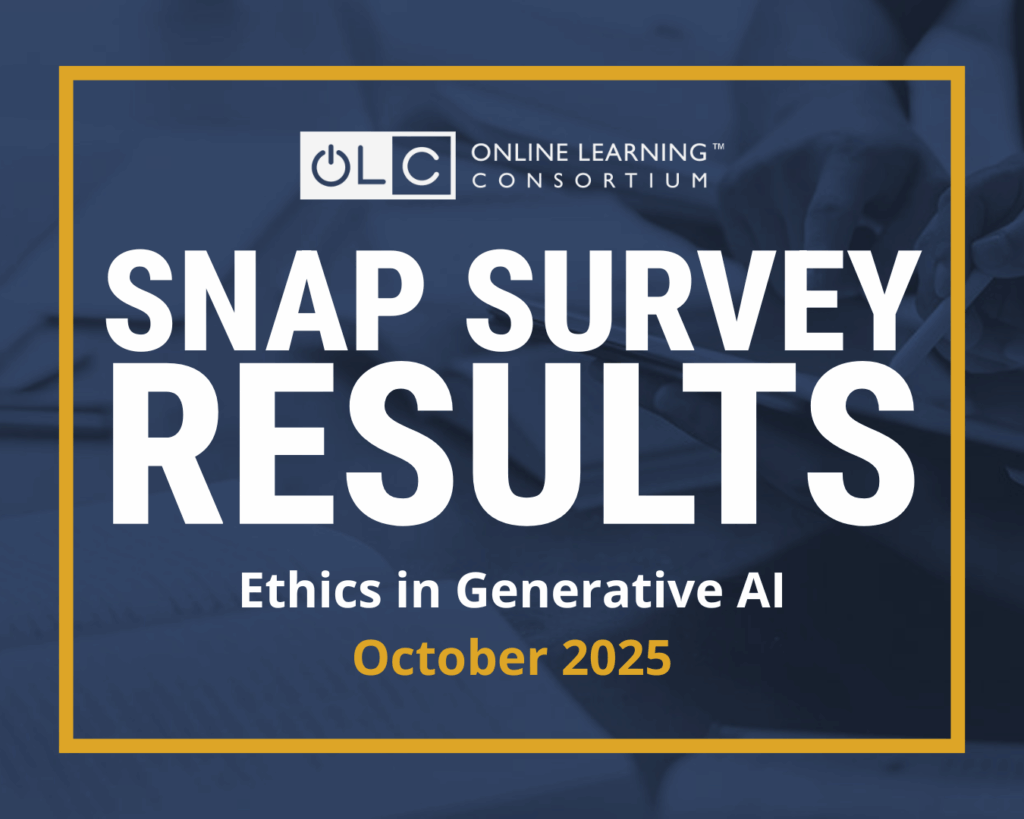In the world of digital education, the vocabulary we use to describe how learning happens has expanded and shifted dramatically over the past decades. Terms like online learning, hybrid learning, asynchronous and synchronous learning, remote learning, HyFlex, and more have become common, yet their meanings can overlap or evolve with technological advances and changing educational needs. This proliferation of terms can cause confusion for educators and administrators trying to design programs or conduct research. A decade ago, e-learning was often treated as a monolith, but today we recognize a spectrum of instructional modalities. While no one single source can be the ultimate definition—as each institution has flavors even within these modalities—this primer seeks to reflect the existing research as a guide for the OLC community.
Why does clarity in definitions matter? As noted by leaders in online education, the diversity of modalities has complicated our ability to share research findings and best practices because we lack a shared set of definitions to distinguish among the many variations (Mayadas et al, 2015). Having common terminology directly impacts how we design courses, how we measure outcomes, and how we set policy (Johnson et al., 2022).
Digital Learning and E-Learning
Digital learning and E-learning are often used interchangeably to describe education that leverages digital technologies to facilitate learning. Both terms refer to instructional practices that utilize internet-connected tools, platforms, and resources to support teaching and learning regardless of time or place. This includes fully online courses, hybrid and blended models, and digitally enhanced in-person experiences. These modalities may incorporate synchronous, asynchronous, or self-paced components.
While e-learning traditionally refers to electronically delivered instruction, digital learning is the broader term, encompassing formal and informal learning experiences delivered via digital means, including mobile learning, gamified learning environments, and the use of artificial intelligence to support personalized learning. Together, these approaches reflect a pedagogical shift toward more flexible, accessible, and learner-centered environments.
Online Learning
Online learning is an umbrella term for education delivered primarily or entirely via the internet. It can include synchronous or asynchronous components. A course is typically classified as fully online when all instruction and interaction is delivered fully online.
Online learning has evolved into rich, interactive experiences that support collaboration, multimedia integration, and accessibility from anywhere. It is often synonymous with modern forms of distance education.
Asynchronous Online Learning
Asynchronous online learning refers to learning experiences that do not happen in real time. In an asynchronous course, students access materials and complete assignments at their own pace without live interaction with instructors or peers. A schedule of due dates typically guides learners as to when activities should be completed. For example, a fully asynchronous online course might have students watch pre-recorded lectures, participate in discussion boards, or complete weekly modules, but in a flexible way that suits their schedule rather than real-time requirements.
Historically, most online courses in the late 1990s and early 2000s were primarily asynchronous due to limited web conferencing technology. Today, asynchronous learning remains common as a way to make learning more accessible and flexible. Asynchronous instruction meets the needs of working professionals in particular.
Synchronous Online Learning
Synchronous online learning occurs in real-time, with instructors and students engaging simultaneously. This includes live lectures, virtual class sessions, and real-time discussions. The immediacy of interaction is key to the synchronous modality. Technologies like Zoom and Microsoft Teams have made synchronous online learning widely feasible.
This format is useful for fostering community and real-time feedback but requires students to be available at specific times. Increasingly, instructors will also record live synchronous sessions to
Bichronous Online Learning
Bichronous online learning is an emerging modality that blends asynchronous and synchronous components in a deliberately integrated manner. Unlike hybrid or HyFlex models, bichronous learning occurs fully online but combines the flexibility of asynchronous content with the immediacy and interactivity of synchronous sessions. In this model, students complete self-paced, asynchronous tasks such as watching lectures, engaging in discussion boards, or working on assignments while also participating in scheduled live sessions for collaborative learning, feedback, or Q&A.
This approach aims to foster engagement and flexibility, making it particularly suitable for learners who need autonomy but also benefit from structured interaction and real-time support (Martin et al., 2020).
Self-Paced Learning
Self-paced learning allows learners to progress through materials at their own speed, often within a broad timeline. While typically asynchronous, it differs by offering open-ended access rather than fixed weekly schedules. Competency-based learning, which emphasizes the measurement of learning over time, uses this approach frequently with its goal to measure learning instead of time.
Many MOOCs and non-degree programs may also use this format. It supports adult learners who need flexibility, though it also demands high levels of learner motivation and time management.
Remote Learning
Remote learning describes instructional delivery where students and instructors are separated physically, often due to situational constraints. This modality gained prominence during the COVID-19 pandemic as institutions transitioned to online instruction without fully redesigning courses for the web.
Unlike planned online courses, remote learning may replicate traditional classroom schedules using technology (e.g., Zoom) and is often framed as a temporary or emergency measure. Remote learning experiences should not be considered the equivalent of intentionally designed online learning experiences.
Blended Learning or Hybrid
Blended learning or hybrid combines in-person instruction with online components in an integrated fashion. For example, a course might meet in person once a week and conduct the rest of its activities online. This may involve approaches like the flipped classroom where students review materials online and use in-person time for discussion are common examples.
A low-residency program would fit this definition as well. In those programs, a learner may attend on-site a handful of times during a term (e.g., weekend or week-long intensives).
Historically, a hybrid or blended course has been defined as more than 30% of content fully online (Mayadas, 2015).
Hybrid-Flexible (HyFlex) and Flexible Mode Courses
HyFlex learning offers multiple participation options (in-person, synchronous online, and asynchronous online) and lets students choose how they engage for each session (Beatty, 2019). A student could attend in person one week, online the next, or catch up asynchronously based on personal needs.
HyFlex models emerged to support flexibility, especially during disruptions. They are complex to implement but maximize student access. Institutions like San Francisco State University pioneered the HyFlex model, which has since spread widely.
Flexible mode is often used interchangeably with HyFlex but may not integrate all three participation options to meet the definition of HyFlex. It refers to course designs offering various modes of engagement and empowering students to select their preferred mode of participation. Flexible mode supports learner autonomy and adapts to modern demands. By formalizing this approach under a standard term, institutions can better align policy, design, and support systems.
Why Shared Definitions Matter
Shared definitions are essential for:
- Research and data comparison: Consistent terminology ensures meaningful comparisons between studies.
- Instructional design: Clear expectations enable designers and faculty to plan courses aligned with learner needs.
- Policy and administration: Definitions impact compliance, funding, reporting, and scheduling.
Common language helps institutions communicate transparently with learners, faculty, and stakeholders. As instructional modalities evolve, so must our efforts to define and standardize them.
Conclusion
Instructional modalities have diversified alongside advances in technology and shifts in learner expectations. From asynchronous to HyFlex, each modality supports different goals, learners, and contexts. By refining and adopting shared definitions, educators and institutions can promote clarity, foster innovation, and ensure quality across diverse learning environments.
The Center for Professional Learning at OLC can support you in any of these modalities. Whether you’re looking to get started in online learning through our Online Facilitation workshop series and badge, seeking a certificate in Online Teaching or Advanced Online Teaching, or want to dig into specific modalities like Blended Learning or Hyflex, we have an offering for you on our schedule.
References
Beatty, B. J. (2019). Hybrid-Flexible Course Design: Implementing student-directed hybrid classes. EdTech Books. https://edtechbooks.org/hyflex
Martin, F., Polly, D., Jokiaho, A., & May, B. (2020). Bichronous online learning: Blending asynchronous and synchronous online learning. EDUCAUSE Review. https://er.educause.edu/articles/2020/9/bichronous-online-learning-blending-asynchronous-and synchronous-online-learning
Mayadas, F., Miller, G., & Sener, J. (2015, April 4). Definitions of e-learning courses and programs: Version 2.0. OLC Insights.
Johnson, N., Seaman, J., & Poulin, R. (2022). Defining different modes of learning: Resolving confusion and contention through consensus. Online Learning, 26(3), 89–106. https://olj.onlinelearningconsortium.org/index.php/olj/article/view/3565/1193
AI Usage Statement
Portions of this primer were developed with the support of generative AI tools to assist with early drafting, organization, and language refinement. These tools were used under the guidance and authorship of the document’s creator to enhance clarity and alignment with current terminology in the field. All definitions, examples, and source materials were selected, verified, and edited by the author based on established research and professional practice. Care was taken to ensure accuracy, consistency, and citation of all referenced materials.





